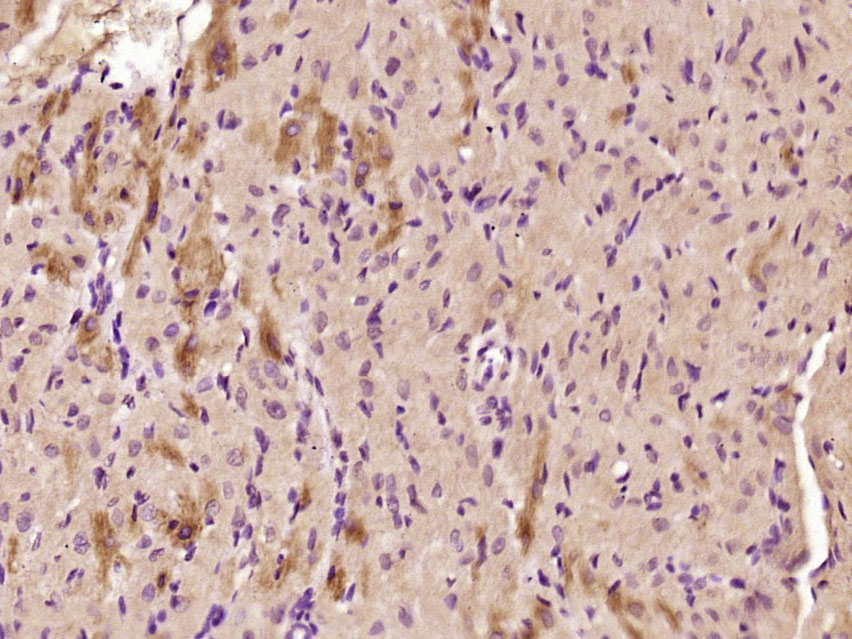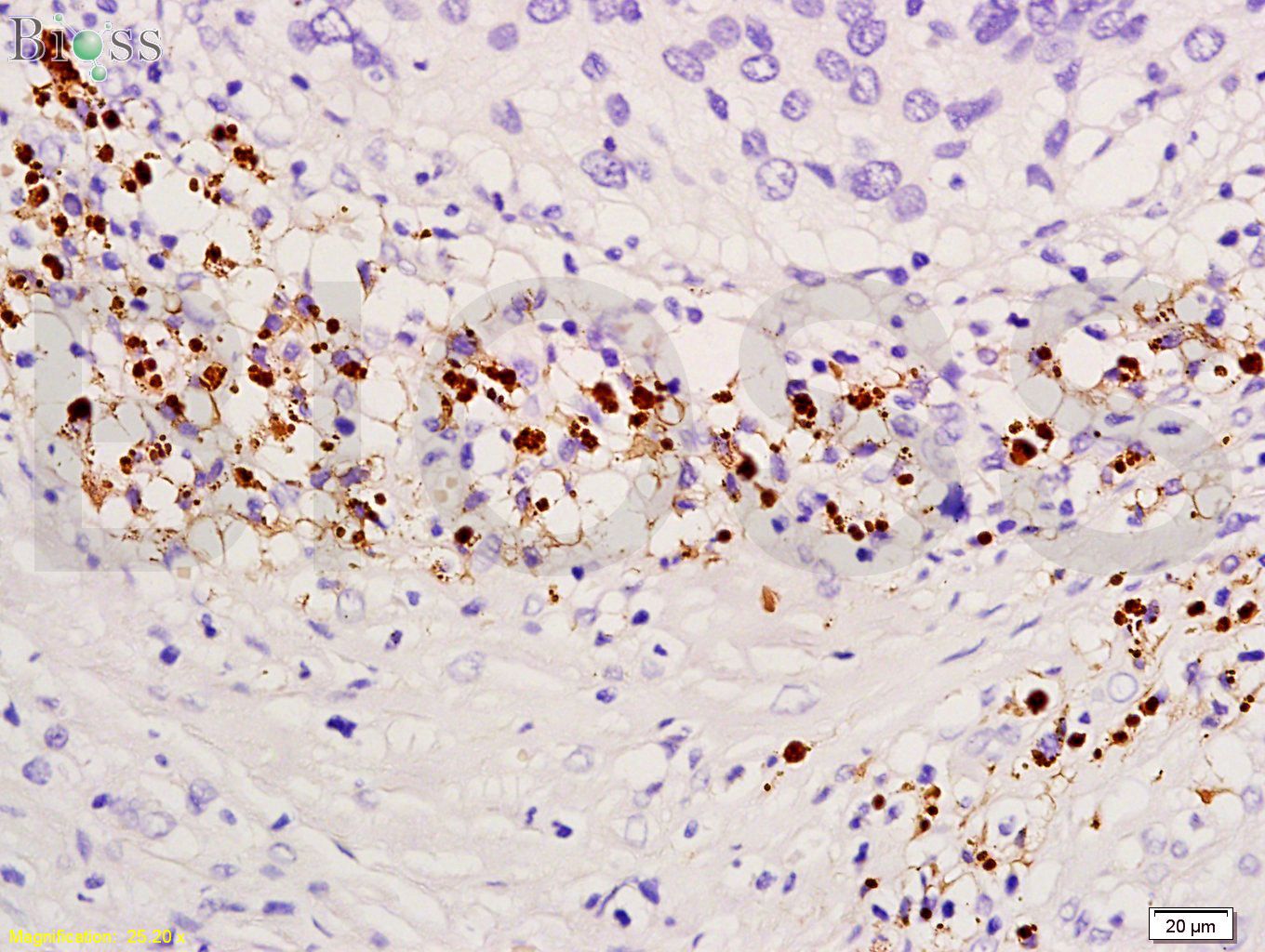
Rabbit Anti-TIMP-4 antibody
Metalloproteinase inhibitor 4; TIMP 4; TIMP4; TIMP metallopeptidase inhibitor 4; TIMP-4; Timp4; TIMP4_HUMAN; Tissue inhibitor of metalloproteinase 4.
View History [Clear]
Details
Product Name TIMP-4 Chinese Name 金属蛋白酶组织抑制因子-4抗体 Alias Metalloproteinase inhibitor 4; TIMP 4; TIMP4; TIMP metallopeptidase inhibitor 4; TIMP-4; Timp4; TIMP4_HUMAN; Tissue inhibitor of metalloproteinase 4. Research Area Tumour Cardiovascular Neurobiology Synthesis and Degradation Immunogen Species Rabbit Clonality Polyclonal React Species Human, Rat, (predicted: Mouse, Cow, Horse, Rabbit, ) Applications WB=1:500-2000 ELISA=1:5000-10000 IHC-P=1:100-500 IHC-F=1:100-500 IF=1:100-500 (Paraffin sections need antigen repair)
not yet tested in other applications.
optimal dilutions/concentrations should be determined by the end user.Theoretical molecular weight 22kDa Cellular localization Secretory protein Form Liquid Concentration 1mg/ml immunogen KLH conjugated synthetic peptide derived from human TIMP-4: 161-224/224 Lsotype IgG Purification affinity purified by Protein A Buffer Solution 0.01M TBS(pH7.4) with 1% BSA, 0.03% Proclin300 and 50% Glycerol. Storage Shipped at 4℃. Store at -20 °C for one year. Avoid repeated freeze/thaw cycles. Attention This product as supplied is intended for research use only, not for use in human, therapeutic or diagnostic applications. PubMed PubMed Product Detail The tissue inhibitors of metalloproteinases (TIMPs) are naturally occurring proteins that specifically inhibit matrix metalloproteinases and regulate extracellular matrix turnover and tissue remodeling by forming tightbinding inhibitory complexes with the MMPs. Thus, TIMPs maintain the balance between matrix destruction and formation. An imbalance between MMPs and the associated TIMPs may play a significant role in the invasive phenotype of malignant tumors. The TIMP proteins share several structural features including six loops held in place by six disulfide bonds arranged in three knot-like structures. These proteins also contain twelve cysteine residues in conserved regions of the molecule that form six disulfide bonds, essential for the formation of native conformations, and the N terminal region that is necessary for inhibitory activities. The N terminus of each TIMP contains a consensus sequence (VIRAK) and each TIMP is translated with a 29 amino acid leader sequence that is cleaved off to produce the mature protein. The C terminal regions are divergent, which enhances the selectivity of inhibition and binding efficiency. Although the TIMP proteins share high homology, they may either be secreted extracellularly in soluble form (TIMP1, TIMP2 and TIMP4) or bind to extracellular matrix components (TIMP3).
The MMPs and TIMPs can be divided into two groups with respect to gene expression: the majority exhibit inducible expression and a small number are produced constitutively or are expressed at very low levels and are not inducible. Among agents that induce MMP and TIMP production are the inflammatory cytokines TNF alpha and IL1 beta. A marked cell type specificity is a hallmark of both MMP and TIMP gene expression (i.e. a limited number of cell types can be induced to make these proteins). Tissue Inhibitor of Metalloproteinases 4 (TIMP4) was identified by molecular cloning. TIMP4 shows 37 % amino acid identity with TIMP1 and 51 % homology with TIMP2 and TIMP3. TIMP4 is secreted extracellularly, predominantly in heart and brain tissue. It may function in a tissue specific fashion in extracellular matrix (ECM) homeostasis. TIMP4 has a strong inhibitory effect on the invasion of human breast cancer cells across reconstituted basement membranes suggesting that TIMP4 may have an important role in inhibiting primary tumor growth and progression. The human TIMP4 gene has the chromosomal location of 3p25.
Function:
Complexes with metalloproteinases (such as collagenases) and irreversibly inactivates them by binding to their catalytic zinc cofactor. Known to act on MMP-1, MMP-2, MMP-3, MMP-7 and MMP-9.
Subcellular Location:
Secreted.
Tissue Specificity:
Abundant in heart and present at low levels in many other tissues.
Similarity:
Belongs to the protease inhibitor I35 (TIMP) family.
Contains 1 NTR domain.
SWISS:
Q99727
Gene ID:
7079
Database links:Entrez Gene: 7079 Human
Entrez Gene: 110595 Mouse
Omim: 601915 Human
SwissProt: Q99727 Human
SwissProt: Q9JHB3 Mouse
Unigene: 591665 Human
Unigene: 255607 Mouse
Unigene: 155651 Rat
Synthesis and Degradation(Synthesis and Degradation)
TIMP-4是TIMP家族的新成员,TIMP-3与TIMP-4同样具有较强的促凋亡、抑制血管生成、抗Tumour浸润作用。
Product Picture
Antigen retrieval: citrate buffer ( 0.01M, pH 6.0 ), Boiling bathing for 15min; Block endogenous peroxidase by 3% Hydrogen peroxide for 30min; Blocking buffer (normal goat serum,C-0005) at 37℃ for 20 min;
Incubation: Anti-TIMP-4 Polyclonal Antibody, Unconjugated(SL0418R) 1:300, overnight at 4°C, followed by conjugation to the secondary antibody(SP-0023) and DAB(C-0010) staining
Partial purchase records(bought amounts latest0)
No one bought this product
User Comment(Total0User Comment Num)
- No comment




 +86 571 56623320
+86 571 56623320




